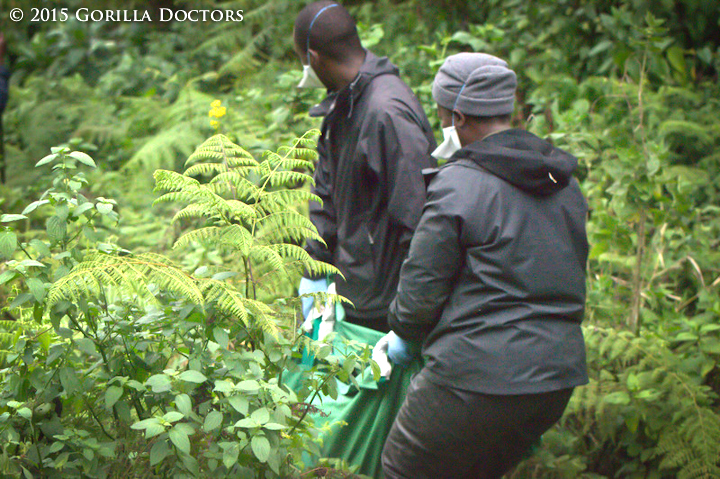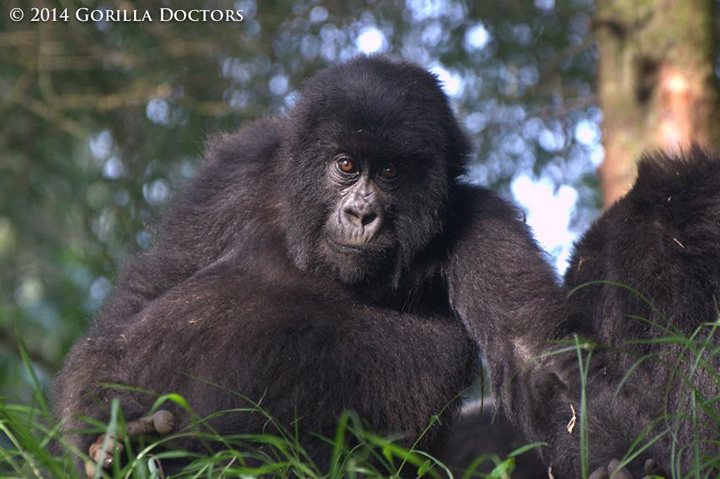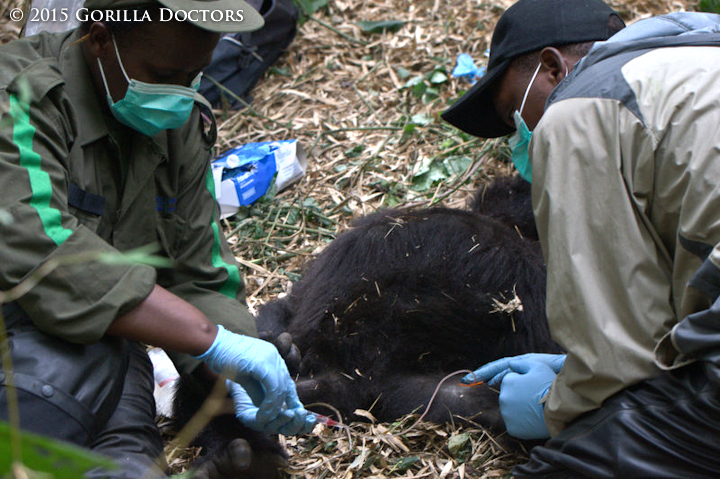Juvenile Agasozindatwa Succumbs to Suspected Tetanus Disease in Rwanda
By Gorilla Doctors Staff on Monday, September 7th, 2015 in Blog.Agasozindatwa, a 5-year-old male mountain gorilla in Volcanoes National Park’s Sabyinyo group, was lethargic and trailing the group when trackers called Gorilla Doctors for a veterinary assessment on August 10. Dr. Noel visited the group the following day in the bamboo zone of the park and found the juvenile in a weakened state and not feeding. In the dense bamboo, it was not easy to visualize each member of the group, but Dr. Noel spotted Agasozindatwa slowly walking towards silverback Gihishamwotsi. The young male had a dry cough and his abdomen appeared distended. He had a wound on his left wrist, which appeared to be healing. He was responsive, but lethargic and held his abdomen as if in pain while walking. His appetite was poor, and he was apathetically picking at Urera leaves, but not actively feeding. Dr. Noel determined that a full medical intervention was necessary to diagnose and treat Agasonzindatwa’s condition.
Early the next morning, Dr. Noel returned to Sabyinyo group, with full intervention kits. He found Agasonzindatwa laying in sternal-abdominal recumbency, but soon slowly got up to follow the group as they moved through the bamboo. Dr. Noel darted the young male with anesthesia and Agasonzindatwa moved close to silverback Guhonda after the dart made impact. Within four minutes he was completely sedated and the RDB trackers had to “push” Guhonda away to allow Dr. Noel to start the procedure.
While no significant abnormalities were found during the physical exam, there were signs of severe dehydration, and Dr. Noel administered fluids to rehydrate Agasonzindatwa. He also administered a broad-spectrum antibiotic, anti-inflammatory, and anti-parasitic medications while the young gorilla was sedated. Our Rwanda Field Vet collected blood and fecal samples, as well as nasal, oral and rectal swabs for analysis and future research.
Dr. Methode Bahizi, Gorilla Doctors Regional Laboratory Technician, analyzed the samples at our Musanze headquarters and found high neutrophils and monocytes suggesting a bacterial infection. The fecal float revealed that Agasonzindatwa also had a high parasite load.
The group had moved during the intervention, so once Dr. Noel was finished with the exam and sample collection, the gorilla was carried to a location in close proximity to his group members before the anesthesia-reversal was administered.

Dr. Noel and Elisabeth carry Agasonzindatwa closer to his group members before administering the anesthesia reversal.
Unfortunately, when Dr. Noel trekked to the group the following morning to follow up on Agasonzindatwa, it was apparent that his condition had deteriorated over night. The gorilla was laying in the same spot where the field team had left him the previous evening, covered in ants. His group members were approximately 1 kilometer away. There were signs that some of the group members had began night nests near their sick group member, but ultimately the group nested elsewhere.
Due to his severely weakened state, anesthesia was not necessary for Dr. Noel to assess his condition and administer additional treatment. Dr. Noel gave Agasonzindatwa a second round of antibiotics, anti-inflammatory, and anti-parasitic medications, fluids, glucose, applied honey to his oral mucosa, and removed as many ants as possible before placing him in a fresh nest. Blood and fecal samples were collected again to assess the progression of his condition.
Over the course of the next week, Gorilla Doctors director Dr. Mike Cranfield, Drs. Noel, Julius, Methode and Gaspard, as well as RDB Veterinary Warden Elisabeth Nyirakaragire, returned to check on Agasonzindatwa and administer additional treatment every day. The vets set up a stomach tube to feed the young gorilla (it had been a week since he had eaten anything) and give him medications. Sadly, Agasonzindatwa was losing body condition from inactivity. During the final intervention, blackback Icyerekezo, the suspected brother of Agasonzindatwa, approached the field team prompting the veterinarians to move back from their patient. The blackback sniffed Agasonzindatwa, the blanket he was laying on, and the tarp suspended above him, before settling in to sit by his side for 45 minutes. When the blackback retreated into the forest and the veterinarians returned, they found that Agasonzindatwa had passed away.
Though Agasonzindatwa’s condition did not appear to be infectious, Sabyinyo group is being monitored closely at this time. Agasonzindatwa is suspected to have died of tetanus, a serious bacterial disease that affects the nervous system. Tetanus is more common in developing countries without access to vaccines, and of course, wild gorillas are not vaccinated against the disease.
“Primates are very susceptible to tetanus” said Dr. Mike. “It wouldn’t be an unusual event. Tetanus is often a diagnosis by exclusion. We hope to find a research lab that will be able to run antibody titers for the toxin which would help. We are also going to be doing histopathology with [Gorilla Doctors Veterinary Pathologist] Dr. Linda Lowenstine over the Internet in 2-3 weeks for the first time.”
In humans, tetanus often involves a deep puncture wound. Occasionally, people will get it from a tooth infection. Agasonzindatwa had broken incisors at the front of his mouth and a puncture wound on the wrist. “It’s an environmental organism and it’s an organism that a lot of people carry” adds Dr. Mike. “You can kill the bacteria… we were giving the specific drugs to kill it at high doses and we also gave the tetanus anti-toxin, but the majority of cases can take 5-11 weeks to resolve.”
Though Agasonzindatwa’s prognosis was grave, our vets were able to give him pain medications and keep him comfortable during his final days. And it is a comfort to know that his brother was by his side when he passed away.


 Donate
Donate


